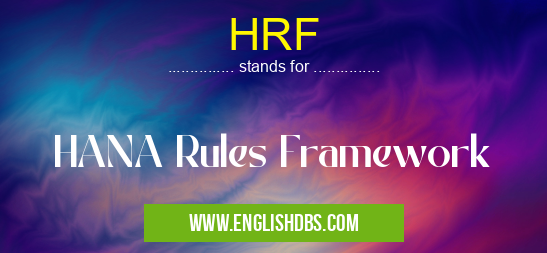What does HRF mean in UNCLASSIFIED
HRF stands for HANA Rules Framework. It is a set of tools and services that enables the development and deployment of business rules in the SAP HANA platform. HRF provides a graphical user interface (GUI) for creating and managing rules, as well as a runtime engine for executing rules.

HRF meaning in Unclassified in Miscellaneous
HRF mostly used in an acronym Unclassified in Category Miscellaneous that means HANA Rules Framework
Shorthand: HRF,
Full Form: HANA Rules Framework
For more information of "HANA Rules Framework", see the section below.
Key Features
- Graphical user interface (GUI): The HRF GUI provides a user-friendly interface for creating and managing rules. Users can drag and drop elements to create rule sets, and use the built-in editor to write rules in a declarative language.
- Runtime engine: The HRF runtime engine executes rules in the SAP HANA platform. The runtime engine is highly optimized for performance, and can handle large volumes of data.
- Integration with SAP HANA: HRF is fully integrated with the SAP HANA platform. This integration allows rules to be executed in the same context as data processing, eliminating the need for separate rule engines.
Benefits of Using HRF
- Improved performance: HRF's runtime engine is highly optimized for performance, which can lead to significant improvements in the execution of business rules.
- Reduced development time: The HRF GUI provides a graphical interface for creating and managing rules, which can reduce development time by eliminating the need for manual coding.
- Increased flexibility: HRF allows rules to be deployed in a variety of ways, including in-memory, on-disk, and in the cloud. This flexibility allows organizations to adapt their rules to their specific needs.
Essential Questions and Answers on HANA Rules Framework in "MISCELLANEOUS»UNFILED"
What is HANA Rules Framework (HRF)?
HANA Rules Framework (HRF) is a declarative, rule-based development framework for SAP HANA. It enables developers to define and execute complex business rules in a central location, simplifying rule management and reducing development time.
What are the key benefits of using HRF?
HRF offers several benefits, including:
- Centralized rule management: Rules are defined and stored in a central repository, ensuring consistency and ease of maintenance.
What types of business rules can be defined using HRF?
HRF supports a wide range of business rules, including:
- Validation rules: Verifying the validity of data and ensuring it meets specific criteria.
How does HRF integrate with other SAP technologies? A: HRF integrates seamlessly with various SAP technologies, such as: - SAP HAN
HRF integrates seamlessly with various SAP technologies, such as:
- SAP HANA: Rules are executed directly on the HANA database, leveraging its in-memory processing capabilities.
Final Words: HRF is a powerful tool for developing and deploying business rules in the SAP HANA platform. HRF provides a graphical user interface (GUI) for creating and managing rules, as well as a runtime engine for executing rules. HRF is fully integrated with the SAP HANA platform, and offers a number of benefits, including improved performance, reduced development time, and increased flexibility.
HRF also stands for: |
|
| All stands for HRF |
